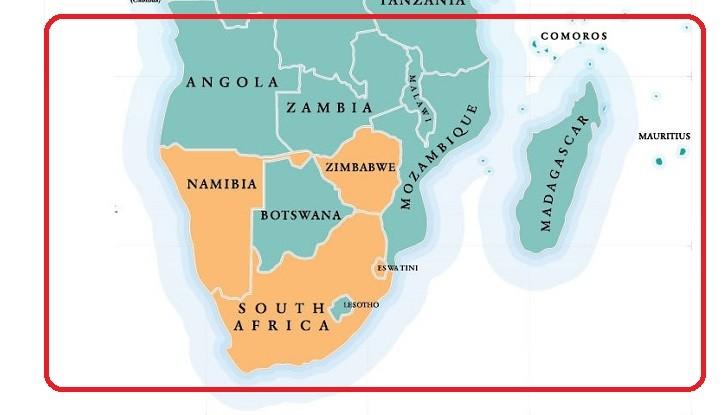The Southern Africa economy is projected to grow slower than others in the continent—at 2.2 per cent in 2019 and 2.8 per cent in 2020.
At the heart of this slow growth are the major headwinds of high inflation, increasing government debt, and slow growth in South Africa, which contributes about two-thirds of the region’s GDP.
The second largest regional economy, Angola, is expected to grow by 1.2 per cent in 2019 and 3.2 per cent in 2020, while Mozambique will grow at 4.5 per cent in 2019 and 5.0 per cent in 2020.
In March, death and destruction were among the cost of Cyclone Idai in Mozambique.
The general macroeconomic environments mixed but stable, with inflation expected to change only marginally from 2018 and remain in single digits except in Angola, where it is projected at 16.8 per cent in 2019 and 12.6 per cent in 2020.
Only three countries will be outside the region’s convergence target while East Africa’s economic growth outperforming African peers.
Currencies depreciation in Southern Africa
Although fiscal deficits are expected to decline in 2019 in most countries, they are above the 3 per cent convergence target except in Botswana and Angola and, very concerning, in Zimbabwe and Mozambique.
Although all currencies are expected to depreciate for various reasons, changes are moderate.
Only Malawi’s will change more than 5 per cent, while Angola’s has been deliberately depreciated to reduce misalignments.
Regional integration and Southern Africa’s GDP
Southern Africa is home to about 209 million people, and its population has grown by about 2.4 per cent a year since 2010. This is slightly below the continent’s 2.6 per cent.
The region contributes about 25.6 per cent to the continent’s gross domestic product (GDP), second after West Africa’s 26.3 per cent.
Despite its economic size, GDP growth has been sluggish, falling from 4 per cent in 2010 to about 1.2 per cent in 2018. Projected growth is estimated to be around 2.2 per cent in 2019 and 2.8 per cent in 2020 which is lower than in other regions. High inflation, rising government debt and low commodity prices are the cause of low growth.
Intraregional trade in the 16-member SADC is far greater than in the 21-member COMESA, without accounting for overlapping memberships.
Integration indices for 2016 show that SADC’s integration is higher than the average of the eight main regional economic blocs but lower than that of the East African Community.
If the index is calculated only for the 12 SADC member countries in Southern Africa, it falls below 0.5, implying that a lot still needs to be done to strengthen economic cooperation and integration in the region.
Only South Africa scores highly across all the five dimensions of the integration index—trade integration, productive integration, regional infrastructure, free movement of people, and finance and macroeconomic integration. It is followed by Botswana, Namibia and Zambia.
The report says that a country’s GDP economic weight, therefore, does not necessarily correspond to its level of integration.
EU, US and Southern Africa’s slow growth
The expected slow growth of Southern Africa’s main exports to the European Union, the United States and China will dampen trade and growth.
This is because the region exports around 33 per cent of its GDP.
The slight decline in the region’s trade and growth is because growth in the EU economy is expected to decline by 0.2 percentage point in 2019, from the 2 per cent expected at the end of 2018, while growth in the United States is anticipated to decline by 0.4 percentage.
The Southern African Development Community (SADC) has taken substantial steps toward sustainable and deeper regional integration more than other regional economic communities (RECs) except the East African Community.
But it is still 47 per cent of the desired target.
That it is not the best performer on any of the five regional integration indices means that it has scope to learn from the best performing RECs.
Several advances can deepen integration in the region: implementing the SADC industrialization strategy, removing nontariff barriers to trade, improving the environment for doing business, finalizing the model laws to harmonize different financial subsectors, and quickly resolving the challenges to ratifying the free movement of people protocol.
Sustainable regional integration in Southern Africa
With the share of the private sector in GDP above 70 per cent in most countries, no regional integration is sustainable without active private participation. The private sector is a beneficiary and driver of regional integration, and governments must create an accommodative landscape.
Public-private partnerships have been successful in other countries for infrastructure development, and reducing trade costs can spur trade.
Steps in the right direction are the Southern African Business Forum, formed in 2015, and stakeholder meetings convened by the SADC secretariat and New Partnership for Africa’s Development (NEPAD) that produced the Savuti, Esibayeni, and Sunninghill declarations.
They recognize the central role of the private sector in implementing the recent industrialization strategy and integration agenda.
This should be complemented by developing regional growth poles to share the benefits from integration across the region.
The use of special economic zones and innovation hubs should be encouraged to nurture nascent industries, promote diversification, and convert the latent comparative advantage into a competitive advantage.
You can also read about why Central Africa is dragging Africa’s growth, AfDB local languages to promote regional integration and Mozambique’s private sector development acceleration attracting Portugal.
